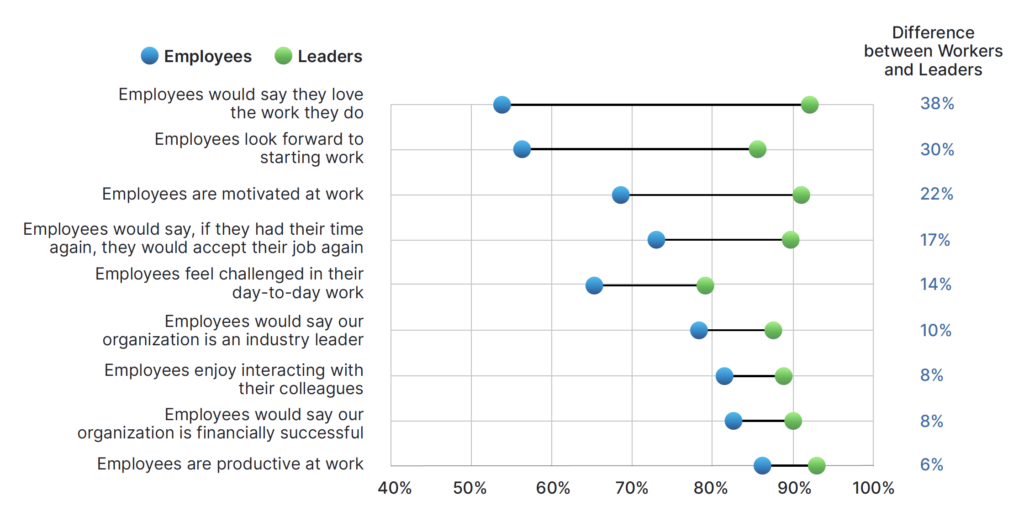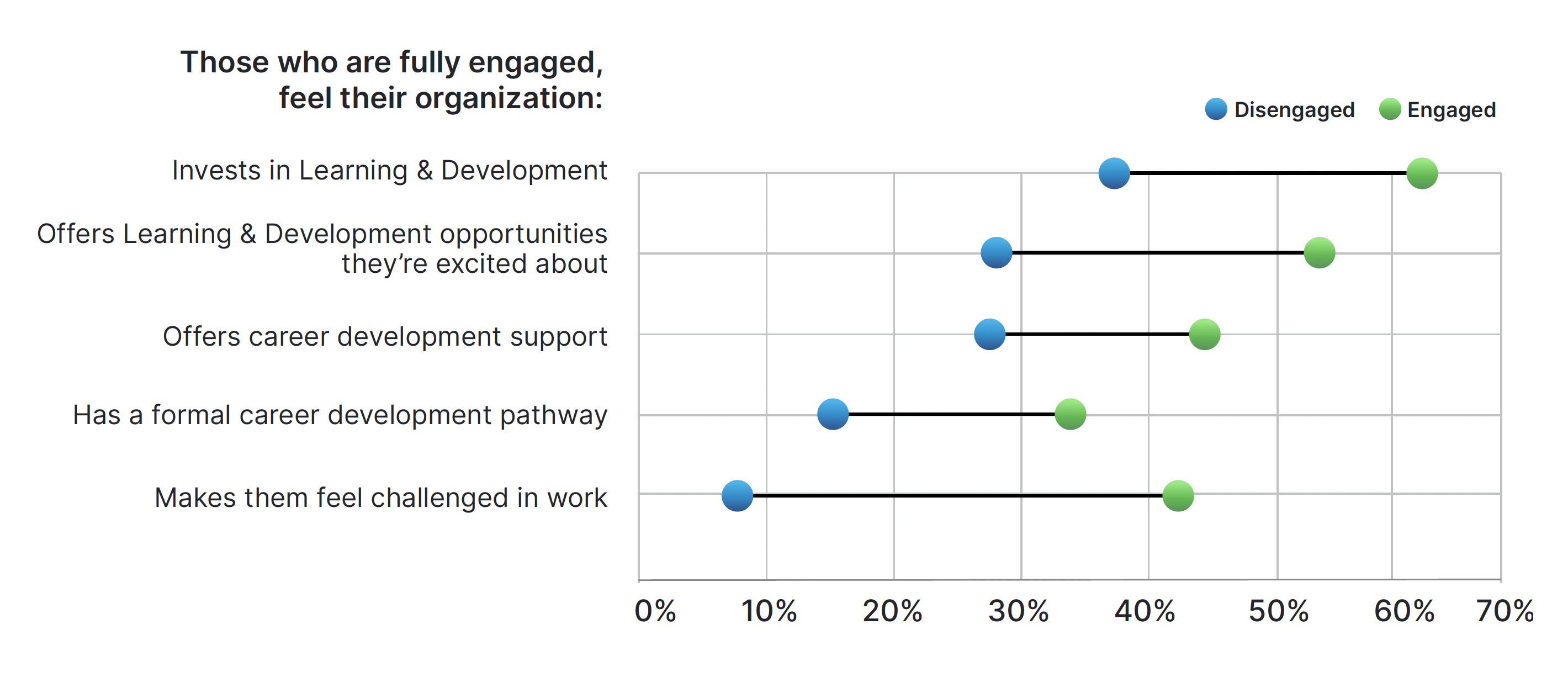
What is the Middle and Why Develop it?
Becoming a learning organization with a growth-oriented mindset means investing in development efforts that directly grow the largest segment of your employee population, AKA the middle. The middle represents 80% of your company – individual performers and front-line leaders, high potentials, keepers of your intellectual property, and future leaders. The middle is the engine that keeps your organization running.
An increasing number of employees aren’t interested in leadership roles, so retention won’t always achieved by promising hierarchical growth. Instead of depending on leaders for development, companies need to empower everyone to take ownership of their growth.

What is the Middle and Why Develop it?
The Engagement Illusion
Are your employees truly engaged or just going through the motions? Leaders across industries believe their employees are engaged and loyal to their organizations. This is an illusion. Leaders vastly overestimate the level of employee engagement and wildly underestimate the degree to which employees are disengaged. These are the key findings of Right Management’s 2024 State of Careers research conducted among more than 400 leaders and 1,000 employees across the United States.
With visibility into both viewpoints—those of leaders and employees—Right Management concludes that North American employee engagement is in a state of crisis. The Great Resignation has made way for the Engagement Illusion. There is a strong disconnect between leader perceptions and employee reality. Given the potential negative impacts of low engagement, organizations must address this disconnect head-on by prioritizing talent and career management, particularly with those employees who are partially engaged and those in the middle of their careers.
What Leaders...and...Workers Say About Engagement
When asked how engaged their workforce was, 83% of leaders responded that their workforce is fully engaged, while only 6% of leaders believed their employees were disengaged. In reality, only 48% of employees would categorize themselves as fully engaged, while 29% are actively disengaged. This suggests a large gulf between what leaders think and the actual reality—the majority of leaders grossly overestimate the number of engaged employees and underestimate the number of disengaged employees.


Leaders Overestimate (Almost 2x) How Much Employees Enjoy their Work
This disconnect extends beyond engagement. In fact, leaders overestimate employee morale across the board, assuming employees love their work at twice the rates of reality. By similar margins, leaders misjudge their employees’ motivation level, job and employer satisfaction, and the degree to which workers feel they belong. Sadly, many employees say they would take another job given what they know now.
Employees Are Also Less Loyal than Leaders Think
Leaders overestimate the degree to which employees plan to stay at the organization for the foreseeable future. Employees want to be loyal; their needs just are not being met, leading them to reluctantly look for other opportunities. While three-quarters of employee participants noted that they’d like to stay at their organization for the foreseeable future, half of employees are open to taking steps toward taking a job elsewhere, be it actively looking or being open if a role was offered. Leaders also overestimate (by 39%) the proportion of employees looking for other roles within the organization. Only half of the employees surveyed are considering career opportunities within their organizations, suggesting organizations could be more effective at providing pathways for internal mobility and making employees aware of internal opportunities.

An Unexpected Relationship Between Engagement and Retention
While it’s common knowledge that engaged employees are more likely to stay at their organizations, our study found an unexpected relationship between engagement and retention. Specifically, engagement does not always result in higher intentions to stay at the organization. Only highly engaged employees are more likely to remain at their organizations. Those who are somewhat engaged were just as likely to leave as disengaged employees. This means efforts should focus on bringing somewhat engaged employees to being fully engaged. Failing to bring a high number of employees up to the fully engaged level will result in employees “voting with their feet” as they exit the organization.
The Least Engaged Employee Segment: The Middle
Breaking down the data uncovers interesting new insights about where the somewhat engaged population exists within the organization. Typically, new hires and senior professionals (e.g., VP and up) are the most engaged, satisfied and loyal employees. There are logical reasons for this: new hires tend to be optimistic about their future within the organization, while tenured staff have consciously chosen to stay, are most satisfied with their jobs and, therefore, are content with their trajectories.
The concern lies with the middle employees—those with three to five years at the organization and fewer than ten years of experience. This group is the least likely to be engaged due to uncertainty over their career paths within the organization. This, in turn, makes them most likely to leave the organization in search of new career and development opportunities.
Van der Mandele notes this dynamic is similar to that of “middle” siblings. “Like firstborn siblings, tenured employees have an established position and are generally reliable performers, while new employees are like the youngest sibling getting all the attention. Meanwhile, the middle siblings frequently end up feeling overlooked.” When it comes to level in the organization, like the longest tenured employees, the most senior seem to be the most content. This suggests a need to focus more on the engagement of employees in middle management or individual contributor roles.

The Light at the End of the Tunnel: Investing in Employee Development Drives Engagement
Fortunately, there is a light at the tunnel for leaders, once they overcome their engagement illusion. There is strong evidence that points to a recipe for leadership to rebuild engagement with their employees and drive long-term loyalty. Fully engaged people believe that their organization invests in learning, offers exciting educational opportunities, provides career development support, has formal career paths and provides challenging work. Organizations and their leaders must then meet employees where they are. Specifically, organizations must build, enhance, and reimagine their career development and talent management strategies to mitigate the risks related to medium and low engagement.

What is the Middle and Why Develop it?
Democratize Coaching for a
Multi-Generational Workforce
Lorem ipsum dolor sit amet, consectetur adipiscing elit, sed do eiusmod tempor incididunt ut labore et dolore magna aliqua. Ut enim ad minim veniam, quis nostrud exercitation ullamco laboris nisi ut aliquip ex ea commodo consequat. Duis aute irure dolor in reprehenderit in voluptate velit esse cillum dolore eu fugiat nulla pariatur. Excepteur sint occaecat cupidatat non proident, sunt in culpa qui officia deserunt mollit anim id est laborum.
Lorem ipsum dolor sit amet, consectetur adipiscing elit, sed do eiusmod tempor incididunt ut labore et dolore magna aliqua. Ut enim ad minim veniam, quis nostrud exercitation ullamco laboris nisi ut aliquip ex ea commodo consequat. Duis aute irure dolor in reprehenderit in voluptate velit esse cillum dolore eu fugiat nulla pariatur. Excepteur sint occaecat cupidatat non proident, sunt in culpa qui officia deserunt mollit anim id est laborum.
The Middle = Mostly Millennials
There are currently five generations in the workforce, but by 2025, 75% percent of the global workforce will be made up of Millennials.
(Source: Deloitte)
Cost of Millennial Job Turnover
Millennials’ job turnover costs the United States economy around $30.5 billion per year.
(Source: Deloitte)
Millenial Engagement
Just 29% of millennial employees say they are engaged at work, and 21% of millennials have changed jobs within the past year.
(Source: Deloitte)
Advancing Careers
67% of Millennials and Gen Z wants to work at companies where they can learn skills to advance their careers.
(Source: Deloitte)
Learning is the Key
76% of Millennial and Gen Z learners think that learning and development is the key to a successful career.
(Source: LinkedIn)
Development at All Levels
83% of businesses say it’s important to develop employees at all levels, yet only 5% of companies have implemented development at all levels.
(Source: Gallup)
Mid-Level Development
Only 27% of HR leaders rate the quality of their mid-level employee development programs as high or very high.
(Source: DDI)
Learning and Connection
7 out of 10 people say learning improves their sense of connection to their organization.
(Source: DDI)
The Middle = Mostly Millennials
Companies are estimated to spend as much as $50 billion per year on employee development.
(Source: Deloitte)
What is the Middle and Why Develop it?
Help Employees Take Charge
of their Own Career Path
Your employees, especially those in the middle, are expecting clarity when it comes to what their future looks like at your organization. But even though career pathing is critical to engagement and retention, it’s often stalled due to lack of transparency, communication, and perceived growth opportunities. The solution is understanding that career pathing is not just upward mobility, but lateral development opportunities in a current role.
Modern day career pathing is a self-driven, collaborative effort between an employee and their manager. Creating a culture where employees take ownership of their own career growth and development, encouraging managers to support but not drive, is the key to successful career pathing.
Career Expansion
76% of employees are looking for opportunities to expand their careers.
(Source: Gallup)
Reaching Full Potential
74% of workers say that a lack of employee development opportunities is preventing them from reaching their full potential.
(Source: Gallup)
Setting Career Goals
Learners who set career goals are 4x more engaged than those who don't and 74% of employees want to learn skills to stay employable.
(Source: PWC)
Career Confidence
Just 25% of employees are confident about their career at their current organization.
(Source: Gartner)
Career Progression
Fewer than one in three employees knows how to progress their career over the next five years.
(Source: Gartner)
Providing Career Paths
44% of companies do not provide compelling career paths.
(Source: Gartner)
Role Confidence
Only 25% of employees feel confident about their current role, which has led 75% to browse new roles at other companies.
(Source: Deloitte)
Career Path and Purpose
87% of employees who engage in conversations about their career path find more meaning and purpose in their role.
(Source: Deloitte)
Internal Migration
When employees are able to migrate internally, they stay at a company for approximately 5 years. Companies with low internal mobility have employees that last about 3 years.
(Source: LinkedIn)
What is the Middle and Why Develop it?
Don't Run Away from Employee
Feedback and Reviews
Ongoing challenges surrounding engagement and retention have left managers overwhelmed. They are struggling to provide the growth and development opportunities that employees crave. There is a practical, scalable, and cost-effective tool for ongoing development, but most companies struggle to utilize it correctly. It’s a scary word for most; feedback.
Feedback happens to be one of the most valuable and impactful tools for growth. Though it should be considered a gift, feedback often remains underutilized and unappreciated. Companies who move away from annual review cycles and towards embracing a culture of ongoing feedback will unlock the key to developing the middle.
Millennials and feedback
80% of millennials would rather receive honest feedback and recognition over formal reviews.
(Source: Achievers)
Employees Want Feedback
96% of employees say getting regular feedback is a good thing and 83% of appreciate feedback, regardless if it’s positive or negative.
(Source: OfficeVibe)
Waiting for Feedback
Employees crave feedback on an ongoing basis. 32% of employees, however, say they wait three months or more to receive feedback.
(Source: OfficeVibe)
Acting On Feedback
Only half of employees consistently act on the feedback they’re given.
(Source: OfficeVibe)
Feedback and Engagement
80% of employees who say they have received meaningful feedback in the past week are fully engaged.
(Source: Gallup)
Create a Feedback Culture
62% of employees wish they received more feedback from their colleagues.
(Source: OfficeVibe)
Quality Over Quantity
64% of employees think the quality of the feedback they receive should be improved.
(Source: OfficeVibe)
Feedback Reduces Turnover
Companies that conduct regular feedback can reduce turnover by 15%
(Source: Gallup)
Feedback from Managers
Employees who receive constructive feedback from their manager had 2.5 times higher engagement rates than employees who did not.
(Source: DDI)
FlexYourWay: Solutions for Developing the Middle
Right Management’s FlexYourWay solutions are affordable employee development programs that target the middle of your organization. The self-directed, online learning courses include 1:1 coaching and are designed to help employees own their own career as well as learn how to invite, give, and process feedback.
Building the right development strategy, especially for the middle of your organization, takes help! Fill out the form and one of our experts will be in touch within one business day.
